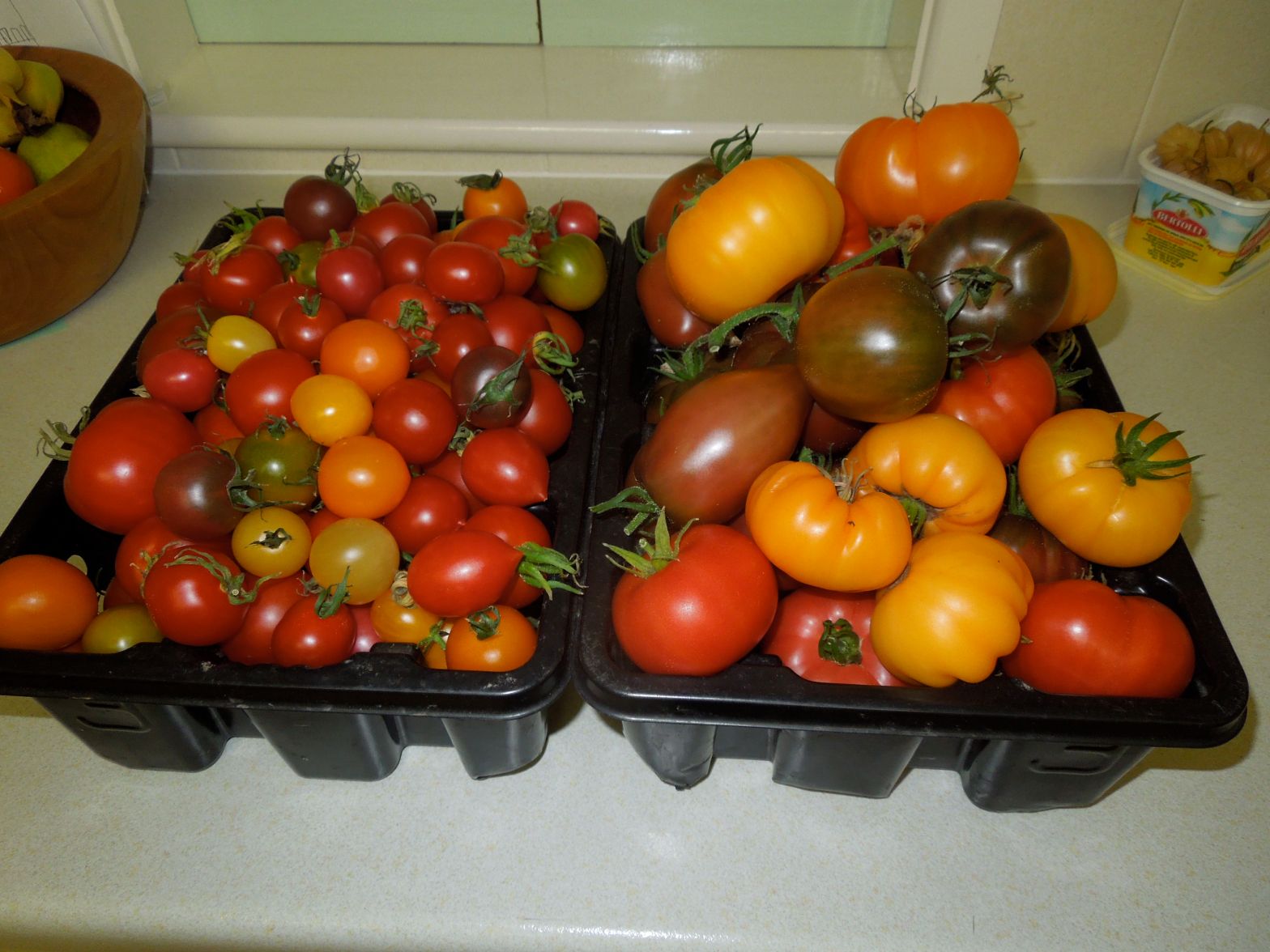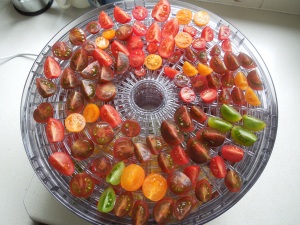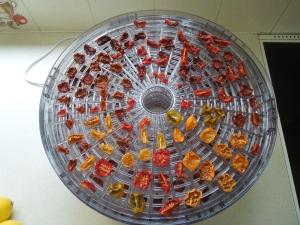OK, the 2015 tomato season is now well and truly over, and we can look back on the year and look forward to next.
We always seem to start these reviews by thinking what a strange year it has been (maybe the point is that British weather is never consistent and so we have to allow for it). However, this year started with the decision not to grow plug plants for sale. There were two reasons, first
- not having a temperature and light controlled greenhouse meant that is was difficult to manage the seedlings through their early stages, taking them in and out of the house at night was a pain and equally well on the sunny days when the temperature in the greenhouse rose to 40C and higher stressed the plants; second
- competition: more of the major nurseries are selling tomatoes as plug plants and their prices mean that its really quite difficult to make it worthwhile for people to consider us.
This decision made life simpler all round. Many fewer plants which I could sow at a time that suited me, transplanting to pots at the right time, etc., etc..
The weather was variable through the spring colder than some other years, particularly at the end of April where we had unseasonably cold weather for a few days with the cold continuing through May and into June although late June warmed up significantly. Early July was hot (with high temperatures affecting the plants in the polytunnel) but the end of July returned to the cooler and darker weather that we’d experienced earlier in the year. August remained cool, although with the odd hot day, which would bring about thunderstorms. Early September was bright and warm but by this time the growth of the tomatoes had finished and later in the month it returned to cooler conditions. So overall, not a good year for tomatoes.
We also reduced the number of plants that we grew, last year’s crop of 70+ kilos of tomatoes proved to be more than we could eat sensibly and our plan was to reduce the number of tomatoes to a more manageable quantity. We reduced the number of different varieties even more as we decided to grow at least two plants of each of our chosen varieties and even more of the two versions of Oleron Yellow that we are growing on to make sure that we had consistent growth in the various seeds that we had collected.
One mistake that we made was to not consider the colours of the varieties we had chosen to grow and as a result about half of the tomatoes we grew were yellow which has made them more difficult to save as sauces as a yellow tomato doesn’t produce the “right” colour.
However, all in all it was an interesting year, 58 plants of 28 different varieties (of which nine were new to us) and a total crop of just over 48kilos.
One of the plants that we grew was Crimson Crush. This was supplied as plants by Dobies and Suttons Seeds and is an F1 hybrid which is supposedly “Blight Resistant”. So we duly planted them out at the allotment along with a couple of other plants and … we got no blight at all. The tomatoes were attacked by slugs and really didn’t produce many ripe tomatoes. Then, after we’d picked the green tomatoes and put them in a drawer to ripen off, many of the tomatoes became blight ridden. What I can’t tell (because I didn’t separate the green tomatoes) is whether Crimson Crush was affected by the blight or not. All I know is that the plants struggled in the cold early on and went purple in October before I pulled them up.
The good intentions for 2016 include:
- Making sure that I have a better look at the colours to make sure that no more than 25% of the plants are yellow; and
- Making sure that I get a better balance of cherries, beefsteak and standard (1/3rd of each rather than 45% each of cherry and beefsteak and only 10% standard).
My plans for 2016 will include buying plants from other suppliers rather than seeds so that I can see whether they are better than growing my own tomatoes from seed.
Detailed Results
Beefsteak
Yellow Beefsteak
This year we grew Azoychka and Limmony. To be perfectly honest, its difficult to tell the difference between these two varieties and so only one will be grown in 2016. Limmony have consistently outperformed Azoychka for the last three years so the writing is on the wall.
Orange Beefsteak
We grew Summer Cider and Marvel Stripes and will possibly do so again in 2016. They are both excellent tasting fruit (Summer Cider consistently tastes the best) and they match together perfectly, Summer Cider (whilst late) is earlier than Marvel Stripes which takes over late in the season.
Red Beefsteak
We grew Abraham Lincoln, Chianti Rose and Crimson Crush. All were new to us. None grew over 1kg per plant (although Crimson Crush was grown outdoors so its a little unfair) but neither had a exceptional flavour so they won’t be grown in 2016. (The only proviso on this is that we are planning to try and overwinter some Crimson Crush sideshoots to see if we can grow them on through to 2016).
Black Beefsteak
We grew three varieties (but only one plant of each), Black Brandywine, True Black Brandywine and Black Russian. None produced over 1kg of fruit and none tasted better than Japanese Black Trifele. So, there will be a different choice for 2016.
Cherry
Red Cherry
The red cherry varieties we grew were: Chadwick Cherry, Gardener’s Delight, Garden Pearl, Hundreds & Thousands and Koralic Red Cherry. The last three are determinate and we grow them so that we can use the bench space in the polytunnel for tomatoes. They all did well, with Hundreds & Thousands and Koranic Red Cherry each producing over a kilo of small tasty fruit. To be honest, the difficulty with Hundreds & Thousands is that the fruit are very small (under 2 grams) and so picking a kilo of fruit is a long winded process. Chadwick Cherry were much more successful this year than 2014 and there’s little or no visible difference between them and Gardener’s Delight.
Black/Purple Cherry
We grew Chocolate Cherry, Rosella and Brown Berry. Chocolate Cherry was new to us and has a colour and flavour almost exactly the same as Rosella although the fruits are slightly larger. Rosella and Chocolate Cherry are both prone to splitting and our favourite of these varieties remains Brown Berry.
Green Cherry
We grew Emerald Green Cherry for the first time this year and they were a bit of a disappointment. Like all green tomatoes, there’s a problem trying to decide when the fruit is ripe and these were too tart if picked underripe and mealy if picked overripe. The jury is out but overall, Green Grapes is probably preferable.
Yellow Cherry
The only yellow cherry tomatoes we grew were our “Oleron Yellow“. They were tasty as ever but we’ve definitely got two different varieties, one slightly darker than the other. Of the two the paler is the one we prefer.
Orange Cherry
We grew Orange Berry this year and it didn’t do very well, less than half the crop for the last two years. They still taste excellent but the total weight of fruit was a disappointment.
Standard Tomatoes
Red/Pink Standard
Our red standard tomatoes were Alicante, the Amateur, Bloody Butcher, Egyptian, Moneymaker, and Nectar Rose. Nectar Rose and Egyptian were new to us and Moneymaker we would not normally grow because we think there are others with a better taste. Bloody Butcher we grow because its always early (as they were this year). Nectar Rose and Moneymaker produced well, Egyptian and the Amateur less so. We will find an alternative mix for next year but will probably try Egyptian again to give it another try.
Conclusion
Another challenging but entertaining year and nothing to stop us trying again next. We will have fun and hope that you do as well.
PelicanPlants



